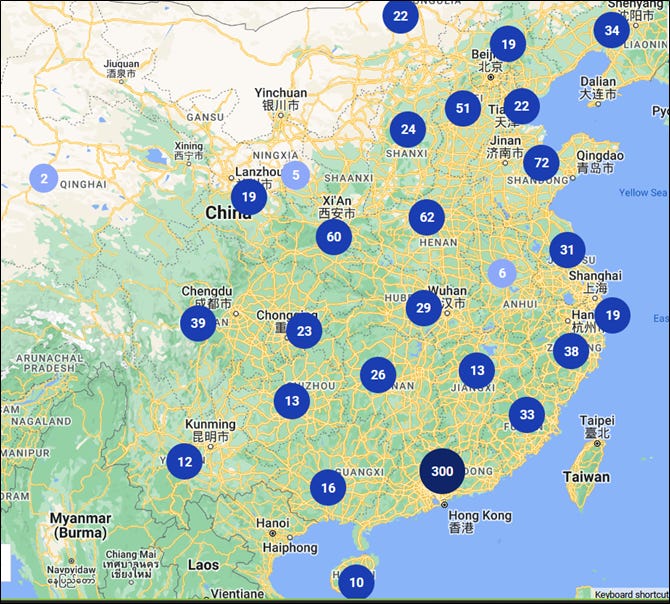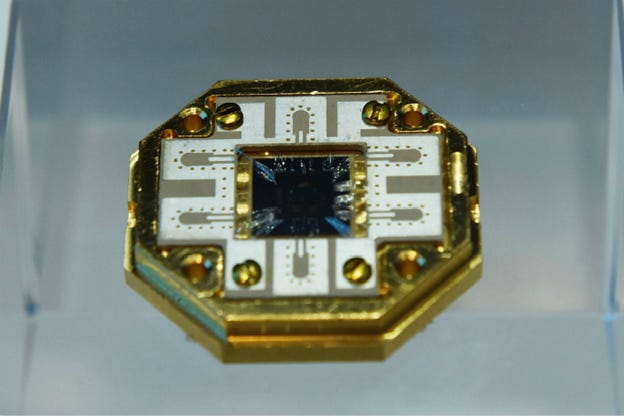China Is In The Chip Race As The Yardstick Keeps Moving
U.S. workers join with tech companies to plan AI future
There is a world of wealth open to the purveyors of the very small.
The global market for computer chips is around $570-billion now, expected to double to more than 1.3 trillion within five years. This gives it a growth rate of more than 12% a year.
The most valued of the chips are the smallest: those below 7 nanometers (nm) in size. The smaller the nm, the tighter the transistors can be packed and the shorter the distance is between each transistor. Since the electrons have to travel a smaller distance, the electrical signal passes faster and thus results in faster processing.
The standard for chips these days is between 5–7 nm. A human hair is 80,000–100,000 nm, so we’re talking about chips that are thousands of times smaller than a hair.
(Things move fast. Researchers have gotten chips down to 1 nm, but that was so last year…)


Under Biden’s 2022 CHIPS and Science Act subsidies were allotted to chip manufacturers to build chips in the US. Companies in Japan and Netherlands-based ASML were persuaded to stop sales to China of the advanced machines needed for the manufacture of very fast semiconductors.
But at the time, ASML leaders warned that the ban would only encourage the Chinese to develop the equipment for themselves, and that it was only a matter of time before that day would arrive.
Now, more quickly than even ASML had forecast, Chinese companies seem to have done just that.
Shanghai-based Semi Conductor Manufacturing International Corporation (SMIC) — China’s leading chip maker — has developed a lithography machine capable of producing transistors comparable to those produced by ASML.
This will be welcome news for Chinese companies like Huawei, which doesn’t make its own chips and has until now relied on manufacturers like Taiwan’s TSMC. Due to U.S. sanctions, TSMC became inaccessible for Huawei’s chip procurement.
In September, Huawei’s Mate 60 smartphone revealed it used a 7-nanometer chip node for its processor.
Former TSMC vice president Lin Burn-jeng believes that SMIC can use the machines it already has to further reduce feature size and transition to 5-nanometer. Despite U.S. sanctions on SMIC buying EUV machines, there aren’t any sanctions in place for DUV equipment.
Dr. Lin is a respected figure in the chip sector with over 60 patents and numerous awards from TSMC and IBM. He emphasized that it’s “not possible” for the U.S. to completely hinder China’s progress in semiconductor technology.
The science is available to all; it’s a matter of whether your technology is able to go from deep to extreme.
Deep ultraviolet machines (DUC) uses wavelengths of light in about the 200 nm range to etch the chips. Extreme ultraviolet light (EUV) has a wavelength of 13.5 nm, so it can create far smaller components.
While it’s commonly thought that extreme ultraviolet (EUV) machines are essential for making 7-nanometer and smaller chips, deep ultraviolet (DUV) machines can also be used. However, EUV machines are preferred because they allow for smaller circuits to be printed faster and with fewer errors.
TSMC’s had the first chip to use EUV technology. While the term “7-nanometer” describes chips with feature sizes as small as 7nm, the TSMC device can go down to 6 nm.
This development indicates Huawei and SMIC’s determination to advance in the semiconductor industry despite challenges and restrictions.
Rather than try to control access to what exists by banning technology, Washington would have done better to stimulate firms to develop the next generation of technology — to keep one step ahead.
There is another development, more in the social field, that foreshadows a continuing American lead in the area.
It has nothing to do directly with the technology, but rather with the social pay-out from its use.
This will be harder for a foreign rival to duplicate.
Microsoft and the nation’s largest federation of labor unions have just launched a partnership to train workers and leaders on how artificial intelligence (AI) is used in the workplace. There are rising concerns from workers and labor unions that AI could lead to job losses.
The AFL-CIO comprises 60 national and international labor unions representing 12.5 million people.
The new partnership “is the first of its kind between a labor organization and a technology company” focused on AI, according to a Microsoft press release.
The union commissioned a survey that found that 70% of its people are concerned about AI displacing workers, with women being more concerned about “AI’s potential to exacerbate inequity on the job.”
Interestingly, in light of the rabid push-back against unions by some tech giants like Amazon and Tesla, the agreement confirms a joint commitment to respect the right of employees to form or join unions, to develop positive and cooperative labor-management relationships, and to negotiate collective bargaining agreements that will support workers in an era of rapid technological change.
Through the partnership, union workers and leaders will receive training starting next winter from experts at Microsoft on AI trends, how the technology works and is developed and what its challenges are. The education sessions will start in the winter of 2024.
The AFL-CIO and Microsoft say they will also “propose and support policies” to train workers on artificial intelligence, including tech apprenticeships. Microsoft will also begin gathering feedback from labor groups and will focus on unions and workers in “key selected sectors.”
The alliance’s goals include “sharing in-depth information with labor leaders and workers on AI technology trends, incorporating worker perspectives and expertise in the development of AI technology” and “helping shape public policy that supports the technology skills and needs of frontline workers.”
Microsoft President Brad Smith says that the partnership with labor unions “can help ensure that AI serves the country’s workers.”
“This partnership reflects a recognition of the critical role workers play in the development, deployment and regulation of AI and related technologies,” said AFL-CIO President Liz Shuler, who called the collaboration “a groundbreaking” and “historic” alliance.
Microsoft will include language governing its use of AI in a contract covering staff at its video game studio ZeniMax. This is part of negotiations with the Communications Workers of America, and is the first US collective bargaining in Microsoft’s history.
The agreement follows a summer of union actions related to the use of AI in the workplace. Hollywood writers and actors went on strike for months partly due to concerns AI could be used to write scripts or replace actors, or trained using material written by writers. The new contracts specify that AI cannot be used to write or rewrite literary material, and studios cannot force writers to use the technology, though writers are allowed to use AI if they have consent from studios.
A separate strike by the Screen Actors Guild-American Federation of Television and Radio Artists labor union ended after an agreement that included mandatory consent from actors or representatives for deceased actors for a studio to create digital replicas, and for studios to compensate performers if their digital replica is being used.
At least 20% of all workers are in jobs that could be replaced by AI. Again, some tech companies are stepping forward to take a lead: IBM CEO Arvind Krishna said the tech giant would stop hiring humans to fill roles that the company believes AI can perform.
As nanotech drives the creation of more powerful chips, greater and greater power will be available in devices that people use directly or have available as invisible support. AI is one of the most consequential developments in technology development today, as it uses people-learning to create human-like responses to situations and questions.
The ability to tap the new power of the machine with a new set of social contracts that protect the worker is in incredibly powerful economic combination.
China is in economic trouble. A monthly government survey of 3,000 factories across China saw all 13 indicators of economic activity — including new orders and prices — decline. Workers are not being paid. Last year, hundreds of workers at the Foxconn technology group’s Apple iPhone factory in Zhengzhou in Henan province clashed with police after unruly protests over delays to payments.
The communist regime in China does not tolerate independent unions.
Go figure.
Union must be affiliated with the All-China Federation of Trade Unions (ACFTU), a government body. This results in “zero trust” between workers and unions, said one expert. The ACFTU is a “complete non-factor in people’s lives”.
A flurry of worker protest videos have surfaced on Douyin, the Chinese version of TikTok, in recent months as slowing demand and supply chain shifts heap pressure on the country’s factories.
But the only comprehensive source of information on China’s labor movements comes from the Hong Kong based China Labour Bulletin, a non-governmental organization.

The Labor Bureau has been moved to remark that “Were these Chinese tech giants to comply with existing labour laws and pay their workers more fairly, this would be a much greater contribution to achieving the goal of common prosperity.”
There is no indication that China has taken any steps to follow through on either current wage problems or anticipated impacts of new technologies, such as AI.
As the Bureau notes: “The first condition in the relationship between workers and employers must be equality, so that both parties are bound by the terms of the contract, and both have the right to consultation and participation in the contractual process. Unfortunately, the contractual spirit is generally absent in China, and the effects of this are constantly made evident in labour policies.”
The two sides are not even at the same table, talking about it.
This happens regularly in America too, but inaction tends to generate headlines and stockholder pressure.
A study published in China in March found that 54 per cent of its jobs are at high risk of being replaced by AI in the coming decades. Workers in product manufacturing and business services are most likely to be hit.
“As jobs evolve alongside the development of AI, workers will need to adapt to activities that require more creativity and social intelligence,” the report said.
“Policymakers will need to provide more mid-career job training and income support for workers caught in the flood of AI to fulfil job transition.”
For a country that does not even allow independent unions, this will be a challenge.
Moreover, social costs in China are going to rise. Within two decades, China’s retirement-age population is projected to surpass the entire population of the United States. By 2040, an estimated 402 million people, or 28 percent of China’s population, will be older than 60 years old — the current legal retirement age for most men in the country — more people than the expected 379 million in the United States that same year.
The state fund to supply China’s pension obligations will likely be depleted within a decade — when the need is the highest.
Thus far, the US is leading in the application of future tech to its work force. China has yet to make that connection — perhaps because its workers are more like production units than mutual future-shapers.
This perhaps should come as no surprise in a country with top-down rule.
But it is not impossible in China, and perhaps they will learn from the US.
But once again, they will be a decade behind the West in the meaning and application of AI, even as they continue to lag behind in the unfolding world of new nano-chip development.
If the US can ensure that investment, not regulations that ban trade, is the prime tool for tech growth, and continues to include the workers in the roll-out, then it will continue to rule the world of GDP growth and rate of innovation — which is the best method of future-proofing.
It’s not time to be complacent, but the odds continue to favor democratic economies.
Written by Barry Gander
A Canadian from Connecticut: 2 strikes against me! I'm a top writer, looking for the Meaning under the headlines. Follow me on Mastodon @Barry





It is interesting that you end your article with concerns for social funding. I am under the impression that is what communism and socialism are specifically designed to do. Experiencing U.S. healthcare for profit, I am not as optimistic as you. The dysfunctional Congress cannot even fund our current obligations much less react to the looming crisis you describe. There is a reason that military organizations and other first responder systems are not democracies. Even corporations are organized top down with clear lines of communication. Capitalism does not require a democracy to operate as China and Vietnam demonstrate.
But, you buried your lede which is the estimate that half of today’s jobs will be replaced by AI and automation leading us to the social welfare crisis you discuss. Currently, human labor is taxed to fund social welfare. The shift to technological labor will logically lead to a wealth transfer from humans to corporations and their machines. Even today, a computer chip factory has few human workers and is almost fully automated. Humans are becoming liabilities rather than assets. How then do we shift the tax burden from humans to the computers and robots replacing us in offices and factories? Do we provide a minimum basic income for everyone so human consumers can buy the stuff the machines produce? Yeah, you can imagine where this is heading. Tax the bots!
Thanks Barry. I can't even imagine how much time you put into researching this one! Let alone taking the time write it in terms that the techno deficient, like me, can understand it. Plus, ending it on the 'up' side. Made my morning and I will definitely be passing this along to my non-Substack friends.